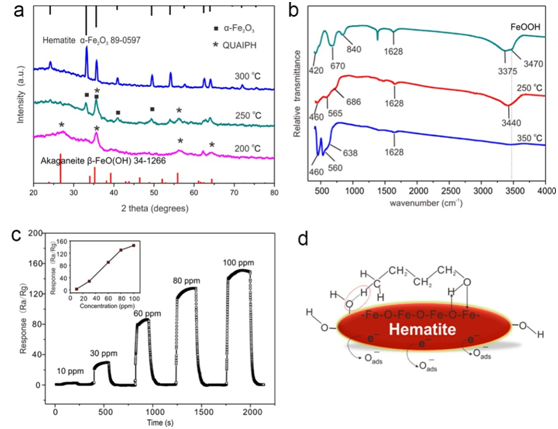N-butanol, a kind of VOCs, is widely used as solvent, organic synthesis intermediates and extracting agent. Exposing to the environment of n-butanol for a long time may cause several symptoms, such as headache, dizzy, drowsiness, dermatitis and discomfort of the eyes, nose and throat. Iron oxide as a n-type semiconductor whose bandgap is 2.1 eV has also been intensively investigated for gas sensing, especially for the detection of LPG, ethanol, acetone, H2S, and H2. However, low sensitivity and selectivity are always the problems for gas sensors based on Fe2O3.
The research group led by Prof. LI Minqiang from Institute of Intelligent Machines, Hefei Institutes of Physical Science, Chinese academy of sciences, prepared highly sensitive and selective Fe-based gas sensors. They have been developed by intermediate state nanocomposites where Quasi-Amorphous Intermediate Phase (QUAIPH) and α-Fe2O3 co-exist converting from fusiform β-FeOOH. The relevant paper is published in Sensors and Actuators B: Chemical (https://www.sciencedirect.com/journal/sensors-and-actuators-b-chemical).
The intermediate state nanocomposites where Quasi-Amorphous Intermediate Phase (QUAIPH) and α-Fe2O3 co-exist got optimal gas sensing responses. TGA, SEM, TEM, XRD, FTIR, BET and XPS was used to characterize the intermediate state nanocomposites. Experimental results reveal that structural hydroxyls facilitate the adsorption of polar molecules, and consequently the probability of adsorption is increased. The crystalline structure of iron oxide favors the transport of electrons, and the synergistic effect of hydroxyl groups and crystalline α-Fe2O3 makes it highly response to n-butanol at an operating temperature of 250 °C.
This work was supported by the National Natural Science Foundation of China (61673367, 31571567, 61504023 and 61573334).

Figure a. XRD patterns of β-FeOOH′s products calcined at 200 oC, 250 oC and 350 oC. b. FT-IR spectrum of β-FeOOH and its products calcined at 250 oC and 350 oC.c. Response–recovery curves of nanocomposites of QUAIPH and α-Fe2O3 to 10-100 ppm n-butanol at 250 °C, the illustration is line chart of the response.d.Schematic diagram of the hydroxyl enhancement sensing mechanism of the spindle-shaped α-Fe2O3 composited with QUAIPH.
Article Link: https://doi.org/10.1016/j.snb.2018.06.081
Article Title : Highly sensitive and selective butanol sensors using the intermediate state nanocomposites converted from β-FeOOH to α-Fe2O3
Key Words: butanol sensors; intermediate state; nanocomposites; FeOOH; α-Fe2O3; Quasi-Amorphous Intermediate Phase (QUAIPH)
Contact:
Prof. LI Minqiang
Nanomaterials and Environment Detection Laboratory, Institute of Intelligent Machines, Chinese Academy of Sciences, Hefei 230031, China
E-mail:mqli@iim.ac.cn
TEL:0551- 65591132
